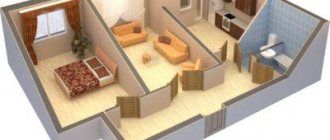The norms of Moscow PP dated October 25, 2011 No. 508 describe in detail what is considered redevelopment in an apartment. The need to transform a living space may arise for the owner after purchasing an apartment in a new building in order to eliminate the initial shortcomings of the builders. Often, owners of residential spaces change them in order to:
- ensure the safety of life, health and property of persons using and owning the apartment;
- make the premises more comfortable and functional;
- adjust the area to current household needs;
- bring the room in accordance with aesthetic preferences.
The general provisions of the Housing Code of the Russian Federation give citizens an idea of what constitutes redevelopment in an apartment. So, in Part 2 of Art. 25 of the Housing Code of the Russian Federation, redevelopment means such transformations of the configuration of the premises, which must be reflected in its technical passport. Among the redevelopment measures in accordance with Art. 2.2 Moscow GD dated October 25, 2011 No. 508 includes the following work:
- installation of load-bearing walls;
- installation or relocation of bathrooms and restrooms;
- dismantling non-load-bearing partitions;
- installation of openings in ceilings, walls and partitions;
- sealing openings;
- improvement of the floor structure without changing the interfloor ceiling.
An apartment redevelopment project must be drawn up when the transformation involves the transfer of property for use and affects the architectural appearance of the building. Such projects are being developed in relation to:
- entrances and vestibules;
- window and door openings;
- awnings and showcases;
- ramps;
- terraces, loggias and balconies located on the first floors;
- chimneys.
Norms Art. 11 Moscow Regulations dated October 25, 2011 No. 508 directly prohibit the following changes during redevelopment:
- deterioration of operating conditions, for example, decreased availability of communications;
- violation of sanitary, hygienic, fire and construction regulations;
- transformations that resulted in the classification of housing as premises unsuitable for habitation;
- reduction in the strength of supporting structures, which can cause damage;
- installation of control devices that change resource consumption indicators;
- decreased conductivity of the ventilation network;
- increasing load on supporting structures, which exceeds permissible standards;
- installation of radiators on balconies connected to the heating and water supply system;
- installation of heated floors that operate from communal heating systems;
- installation of terraces and loggias above the first floor.
Redevelopment is not carried out on technical floors and attics, which are included in the list of common property of the house owners. It is prohibited to transform residential areas located inside dilapidated buildings. Registration of permission for redevelopment is a mandatory step, without which changes to the configuration of the premises are considered illegal. Unauthorized conversion of living space is an administrative offense and entails a fine.
Demolition and construction of non-load-bearing walls: in what cases approval is required
Do I need to approve the relocation of a doorway in a non-load-bearing wall? This option for changing the configuration of an apartment most often raises questions among owners. In their opinion, on the one hand, a doorway in a non-load-bearing wall is a redevelopment, but on the other hand, after such work nothing disappears and nothing new appears, since the opening only moves.
In fact, changes are still present: the area remains unchanged, but the plan will not remain the same. In the BTI technical plan, doors are indicated in certain places.
Relocating an opening in a non-load-bearing wall inevitably leads to a change in the graphic part of the technical plan. Therefore, approval in this case will be required.
But there is one nuance here. As a rule, such work is carried out by re-laying the entire wall.
Is it necessary to legalize the redevelopment of non-load-bearing walls?
- Associated with the construction or removal of load-bearing walls, resulting in the creation of a room without natural light or centralized heating devices;
- As a result, changes occur in the architecture of the building.
It is strictly prohibited:
- Build a gas pipeline into the wall;
- Close ventilation hatches;
- Combine staircases and corridors;
- Change the location of kitchens and bathrooms;
- Connect the territory of the loggia and the area of internal accommodation;
- Carrying out dismantling of thresholds located at the exits from the balcony;
- Dismantling window sill blocks;
- Enlargement of existing openings in external structures at the entrance from the loggia;
- Disassembling the window sill block, if it is used to hold the balcony slab;
- Connection of two residential properties if their owners are different people.
What does not need to be agreed upon when remodeling an apartment?
The reconstruction includes procedures such as:
- Changes in housing parameters;
- Change of communication systems, including reinstallation of heating equipment;
- Any modifications noted in the technical and title documentation for the real estate.
Article 26 of the Housing Code of the Russian Federation establishes a list of works, the implementation of which is subject to obtaining permits from the relevant services:
- Transformation of the location of walls, windows and doorways, stairs between floors, cabinets built into structures, bathrooms and kitchen appliances, sewers and ventilation hatches;
- Changing the functionality of an object inside an apartment.
The concept of reconstruction and (or) redevelopment of residential premises
In the Housing Code of the Russian Federation, compared with Art. 84 of the Housing Code of the RSFSR contains an entire chapter on the issue of redevelopment and (or) reconstruction. Issues of reconstruction and redevelopment of residential premises are established in Art. 25-29 Housing Code of the Russian Federation. Some cases of reconstruction and redevelopment of residential premises are defined in clause 1.7.1 of the Resolution of the Gosstroy of Russia dated September 27, 2003 No. 70 “On approval of the Rules and Standards for the Technical Operation of the Housing Stock.”
A number of technical issues related to redevelopment and reconstruction can be resolved at the level of constituent entities of the Russian Federation and municipalities. An example is the Moscow Government Resolution No. 508-PP dated October 25, 2011 “On the organization of reconstruction and (or) redevelopment of residential and non-residential premises in apartment buildings.”
The concept of reconstruction and redevelopment is enshrined in Art. 25 Housing Code of the Russian Federation.
So, the reconstruction of a residential premises is the installation, replacement or transfer of utility networks, sanitary, electrical or other equipment that requires changes to the technical passport of the residential premises.
Residential renovations may include:
- installation of new and rearrangement of existing gas appliances with the laying of additional supply networks;
- installation of household electric stoves instead of gas stoves or kitchen fires;
- replacement and (or) installation of additional equipment (engineering, technological) with an increase in energy, water consumption and (or) replacement of existing or laying additional supply networks (for non-residential premises).
Redevelopment of a residential premises is a change in the configuration of a residential premises, requiring changes to its technical passport. Redevelopment is carried out while maintaining the functional purpose of the premises.
Redevelopment of residential premises may include activities in which minor changes are made to the layout of the premises, including the integrity of the load-bearing walls of the residential premises is not affected: relocation, dismantling of interior partitions, installation of openings in interior partitions and new partitions without increasing the load on the floors, sealing of door openings in partitions and load-bearing walls, etc.
Also, the redevelopment of residential premises may include measures in which significant changes are made to the configuration of the residential premises, including affecting the load-bearing walls of the residential premises: arrangement (relocation) of restrooms and bathrooms; dismantling partitions, creating openings in partitions enclosing gasified premises; construction of load-bearing walls and openings in ceilings (when combined vertically) with the construction of internal stairs; installation or modification of floor structures carried out in order to repair (replace) existing ones; arrangement of openings in load-bearing walls and inter-apartment partitions; sealing unauthorized openings in load-bearing walls and ceilings; construction and installation work for the manufacture of floors and (or) changes in the design of floors; combining loggias with interior spaces; dismantling (full, partial) of non-load-bearing partitions that accept additional excess load of floors (unloading), etc.
It is possible to carry out a number of works without completing design and permitting documentation:
- cosmetic repairs of premises, including replacement of external carpentry elements without changing the design and color;
- arrangement (disassembly) of built-in furniture: cabinets, mezzanines (not forming independent premises, the area of which is subject to technical accounting);
- replacement (without rearrangement) of engineering equipment with similar parameters and technical design.
Also related to the reconstruction and (or) redevelopment of residential premises in apartment buildings are works, the production of which is associated with the transfer for use of part of the common property and (or) affects the architectural appearance of the apartment building:
- creating entrances, changing entrances and vestibules with the construction of porches (stairs to basements and basements), which does not involve the addition of an additional plot of land;
- creation, elimination, changing the shape of window and door openings in external enclosing structures (walls, roofs);
- creation of entrances (stairs, porches and other areas) to basement or basement premises or to the first floors of buildings within the dimensions of the land plot belonging to the common property of the owners of premises in an apartment building;
- installation of external technical means on the façade that ensure unhindered movement of people with limited mobility: push-out telescopic elevators, double-row handrails, etc., stairs outside the external walls of the building;
- installation of loggias and terraces on the first floors, etc.
Reconstruction and redevelopment are not allowed in which:
- the strength of the building is compromised or the load-bearing structures are destroyed;
- the operation of engineering systems and (or) equipment installed on it is disrupted;
- the safety and appearance of facades deteriorates;
- fire safety devices are broken;
- the operating conditions of the house and the living conditions of all or individual citizens of the house or apartment are deteriorating, etc.
According to Part 1 of Art. 26 of the Housing Code of the Russian Federation, reconstruction and (or) redevelopment of residential premises are carried out in agreement with the local government body on the basis of a decision made by it.
Is it necessary to legalize redevelopment in 2020 when changing non-load-bearing walls?
Important
The application is allowed to be submitted through intermediaries - the government center Coordination of the relocation of the doorway It would seem that the doorway can be easily moved, because the layout of the housing remains the same. In fact, the list of what kind of apartment redevelopment can be done without permission is not that long.
Attention
To change the location of the doorway, you must obtain a permit.
The area remains the same, but the layout of the apartment is adjusted. Those. the BTI plan contains a specific layout of the doorway. But it is changing, so you need to get permission to work. But you can get by with drawing up one sketch if the new design is made in the same place, and only the location for installing the doorway changes. What changes will have to be abandoned. What redevelopment is permitted is determined by law.
What is included in the redevelopment of an apartment
In order not to receive a fine for any violation, you should understand what is included in the redevelopment of an apartment according to the law.
Redevelopment is all construction work that is the basis for making changes to the housing registration certificate.
A simple redevelopment would be, for example, the installation of doorways.
In such a situation, the owner of the premises has the right to personally come up with a sketch and submit it to the regulatory authority for approval.
Redevelopment work is often associated with the load-bearing structures of the building.
With this option, it will no longer be possible to complete the sketch yourself - you will have to contact a special company that will draw up the necessary project.
Reorganization
All types of alterations are included in the redevelopment of apartments. But not all types of changes require approval.
If load-bearing structures are not affected during work, then there is no need to notify government agencies about such reconstruction.
Repair
Many people do not know what is included in the redevelopment of an apartment and mistakenly classify repairs as housing redevelopment. Therefore, let us dwell in more detail on the very concept of the term “repair”.
Repair is the totality of all work that is not classified as either redevelopment or reconstruction.
That is, these are the works that do not require changes to the technical passport.
This includes:
- replacement of wallpaper, doors, windows, plumbing equipment;
- painting the walls.
Such changes do not require special registration, and therefore they can be carried out at any time at your own request.
What redevelopment can be done without permission?
Info
This list includes:
- glazing of loggias or balconies, if this is not accompanied by a change in design (an example is the combination of two balconies);
- moving the doorway, sealing it, enlarging it, creating it or reducing it, if it is not in a supporting structure;
- remaking a doorway into an arch, or a window between rooms;
- changing a shower or bathtub;
- moving the electric stove to another part of the kitchen;
- construction or demolition of storage rooms, wall-mounted ones too.
Attention!
All other cases require the owner to contact the relevant organizations before starting repair work. There you need to get permission to make changes. Legislation Redevelopment of non-load-bearing walls is regulated by the regulations of the Housing Code. The rules are spelled out in Chapter 4. They are the same for owners and tenants.
Does everything need to be agreed upon?
Coordination of major changes in an apartment is an important process that is enshrined in law and is mandatory.
If it was not carried out, then the owner of the home may be held administratively liable.
What is allowed to be done without registration?
Not all redevelopment work requires mandatory registration.
The owner can make many changes independently without approval.
This statement is true if we are talking about a safe redevelopment of the premises, that is, one that does not affect the safety and reliability of the house. With this option, a notification process to special supervisory authorities is sufficient.
Possible situations:
- transfer of plumbing equipment within one room;
- combining toilet and bath;
- dismantling, installation of doorways in walls that are not load-bearing;
- glazing of balconies and loggias.
Permission from housing supervision is not required in the following cases:
- dismantling built-in equipment and furniture;
- redecorating;
- replacing windows with windows of the same size;
- changing engineering equipment to another with similar performance characteristics;
- moving a gas stove within one room without changing any communications.
What types of work are prohibited
At times, apartment owners forget that they do not have the right to do whatever they want in their apartment, despite the fact that the premises are owned. This should be kept in mind during repairs.
First of all, it is prohibited:
- closing or reducing the number of ventilation ducts, which leads to disruption of air circulation in the house;
- excessive load on the supporting structures of the house;
- construction of loggias when the apartment is located above the first floor;
- combining a living room with a gasified kitchen;
- transfer of heating systems to loggias and balconies.
Strict prohibition applies to:
- actions leading to damage to the house;
- violation of construction and sanitary safety, as well as fire safety standards;
- any actions in emergency MKD;
- changing the facade and other external components of a house that is an object of cultural heritage.
Is it necessary to legalize the redevelopment of non-load-bearing walls in an apartment?
Many owners believe that if non-load-bearing walls are demolished or erected during the redevelopment process, then approval is not required. Let's try to figure out in which cases this is really the case, and in which changes still need to be legalized. According to current legislation, redevelopment is considered to be any work in an apartment, the results of which must be reflected in the technical passport of the BTI. It follows from this that sometimes it is still possible to do without approval.
When redevelopment of non-load-bearing walls can be carried out without permission. Repairs that involve dismantling part of the non-load-bearing partitions and erecting them in the same place in strict accordance with the BTI technical passport do not require approval.
Concepts and general information
Redevelopment and redevelopment of residential premises - what is it? In order to understand the difference between adjacent or similar definitions and understand what exactly needs to be done, you need to differentiate the terms.
For example, how to figure out: what is the combination of a bathroom and a toilet? Does this need to be agreed upon and where? What about converting a loggia into a room? Let's try to figure it out.
What is redevelopment in an apartment?
Let's define redevelopment . Redevelopment of residential premises is a serious transformation affecting the technical condition of housing.
The Housing Code of the Russian Federation in Chapter 4 defines this concept as changes that require mandatory inclusion in the technical passport and affect the configuration of the apartment.
It should not be carried out randomly, as this is dangerous and leads to further problems, for example, when selling such housing.
What is renovation ? Reconstruction of a living space is a lightweight option for changing an apartment , which does not require the development of a special project and does not entail a radical change in the original state of the area.
What does this mean for reconstruction? For example, moving a gas stove from one point in the kitchen to another, moving plumbing fixtures within the kitchen or bathroom space, glazing a balcony, redecorating, etc.
What is the difference between reconstruction and redevelopment of residential premises? These two processes are radically different . Among the main differences:
- the obligation to approve changes to the layout and the absence of such a need for reconstruction;
- complexity of the actions and registration;
- the amount of paper being prepared;
- registration cost;
- number of authorities involved;
- registration time, etc.
You can find out about what kind of work to renovate a living space you must obtain permission from various authorities from the video:
Is it possible to demolish a non-load-bearing wall without permission?
Until such a fact is discovered, nothing threatens the owner of the rebuilt apartment, that is, until he decides to sell, donate or exchange his living space. This is where you will discover that until the changes are reflected in the technical passport, it is impossible to dispose of the unauthorized apartment.
Liability The law provides only administrative liability for unauthorized conversion or redevelopment of apartments. In accordance with Article 7.21 of the Code of Administrative Offenses of the Russian Federation, the violator faces a fine.
But the consequences of rash actions do not end there. If violations are discovered that threaten the safety of neighbors, the owner of the rebuilt apartment will have to return the apartment to its original form.
Of course, at your own expense. And if his actions have already caused harm to any of the residents, then he will bear property liability under civil law.
Types of redevelopment that do not require approval
Redevelopment is a change in utilities, such as water supply, sewerage, heating and ventilation. This is stated in Art. 25 of the Housing Code. Attention! If a gas stove is replaced with an electric one, new bathrooms are installed or existing bathrooms are moved, this is also a refurbishment. Changing the configuration inside an apartment is called redevelopment. This concept includes moving partitions between rooms, doorways, reducing or increasing the number of square meters and rooms, as well as the construction of utility rooms. The creation of vestibules in the entrance is also a redevelopment. There is no need to contact the BTI if the owner is planning a routine cosmetic renovation, since this does not imply changing the configuration of the apartment.
Redevelopment and the need for its approval
In order to understand what kind of redevelopment does not require approval, you need to understand what it is.
According to Part 2 of Art. 25 of the Housing Code (hereinafter referred to as the Housing Code of the Russian Federation), redevelopment is a change in the configuration of housing, which requires changes to its technical passport. Part 1 art. 26 of the RF Housing Code provides that in order to carry it out, in all cases you will need to obtain a positive decision from the local government body based on the results of the approval.
Thus, redevelopment without approval is impossible in principle, at least on legal grounds. But you shouldn’t worry about this - perhaps the work you want to carry out does not require changes to the technical documentation of the premises, is not a redevelopment, and can be carried out without documentation. Read about such works below.
What is redevelopment in an apartment?
Some homeowners transform the premises the way they like, but then problems begin when trying to sell the apartment. An example is the installation of a shower stall. The housing company should be notified of this, since in the event of a flood, the deception will become known to government agencies. Attention! The violator must pay a fine, the amount of which reaches 2,500 rubles. After this, you will have to arrange the redevelopment in accordance with all standards. If the services do not give consent, then the apartment will need to be returned to its previous form. It is much more economical to carry out approvals as soon as it was decided to redevelop the housing than to then pay fines and legalize changes in court.






